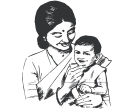By Dr. Rukmani Gopal
The three main players in labour are passage, passenger and forces -For normal labour, Passenger or the baby should be of average in size, around 2.5 to 3 kg is preferable( big-sized babies tend to create problems during labour unless mother also has roomy pelvis).
Pregnant mothers should be encouraged to walk and exercise well during pregnancy so that they have an easy delivery. Improved nutrition in young women with Iron and Vitamin D supplement s and eradication of Polio and TB have reduced the incidence of pelvic bone abnormalities. In 95% of cases, it is a Cephalic presentation which means head down position and in 4%of cases Breach or buttock is down.
Early engagement indicates the greatest diameter of the fetal head passed through the pelvic inlet and head is well within pelvis ruling out obstruction in the passage. Female Pelvis is like a wide mouth basin which has an inlet, cavity and outlet. Pelvic inlet is transversely oval whereas pelvic outlet is longitudinally oval. Hence, the infant’s head and shoulder must go through the specific sequence of manoeuvres in order to pass through the ring of mother’s pelvis.
Click here to read part 1 of this series- Childbirth in the past and present and part 2 of the series- Indications of an elective C-section
Mechanism of labour:
1)Descent with flexion of the baby keeps happening throughout labour to make the baby a compact and avoid mass to fit into the pelvis.The baby’s head becomes ovoid too during descent referred to as MOULDING to facilitate easy passage.
2)Engagement-Once the head is well within the pelvic cavity and not felt per abdomen the greatest diameter of fetal head has passed through the pelvic inlet.
3) Next baby has to rotate forward is called Internal rotation baby’s head enters along the transverse diameter which is widest at the inlet whereas to come out of the outlet which is widest front to back ( anterior-posterior diameter) Internal rotation of the head has to happen for the baby to come to the pelvic outlet.
4)Crowning -occurs when baby’s head is seen at the outlet without receding and the face is towards mother’s rectum.
5)Baby slips beneath the pubic arch and is born by extension of its neck.
6)Restitution or untwisting of baby’s neck occurs and when the head rotates to one side externally along with the shoulder undergoing internal rotation and then the rest of the body of the baby slips out by lateral flexion of the spine.

These mechanisms of labour are happening in quick succession during the second stage of labour and progress of labour much depends upon good uterine contractions hence efficient forces are pre-requisite for normal labour. When contractions are ineffective or baby’s head is in posterior position Internal rotation mechanism is hampered.
Syntocinon drip to accelerate labour along with the use of forceps or vacuum extraction for assisted vaginal delivery is practiced. Every labour is a trial and success or failure depends on the correct selection of cases for vaginal delivery and close monitoring during labour and experience of the midwife or doctor plays an important factor.
Since we are dealing with two lives it is a team work of Obstetrician Neonatologist and anesthetist -all three have to be on call when required and lack of such a setup is detrimental to both mother and baby. Hence CPD and Fetal distress which are the two main reasons for increased incidence of C/S can be corrected if public health care systems have all the facilities and manpower thereby unwanted C-section can be curtailed.
The reason why normal labour is dreaded is the fear of labour pains. This area has much scope for innovation . Pain management during labour with systemic opioid analgesia like Morphine , Pethidine have been used before but they affect the babies.
Epidural is very popular but the mother loses the sensation to push and requires instrumental delivery. Non-pharm logical options like Acupuncture and water immersion are getting popular but require close monitoring. What to expect during normal labour should be explained to pregnant women and these awareness program should be part of Antenatal care and thereby many women would opt for vaginal delivery.
(This concludes Part 3 of the 3-part series on childbirth and C-section by Dr. Rukmani Gopal)
